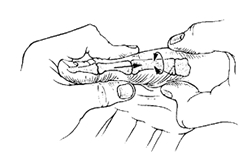Home | Education | Arthritic Conditions | Basal Joint Arthritis
In the hand, the second most common joint to develop osteoarthritis is the joint at the base of the thumb, or basilar joint. The basilar joint of the thumb is formed by a small wrist bone and the first bone of the three bones in the thumb (see Diagram 1). The shape of these bones gives the thumb a wide range of movement – up and down, across the palm, and the ability to pinch with each finger. Basal joint arthritis is commonly known as thumb arthritis.
Dr. Smith provides a comprehensive multidisciplinary approach for the evaluation, treatment and care of thumb arthritis.
Basal Joint Arthritis/Thumb Arthritis Treatment and Surgery
By Houston Hand Surgery Specialist & Orthopaedic Surgeon, Dr. Dean Smith
Any condition that irritates or destroys a joint is called arthritis. In a normal joint, cartilage covers the ends of the bones and allows them to move smoothly and painlessly against one another. With osteoarthritis (also called degenerative arthritis), the cartilage layer wears out and the bones rub against each other. As the cartilage layer continues to wear out, symptoms of arthritis develop and the joint is eventually destroyed.In the hand, the second most common joint to develop osteoarthritis is the joint at the base of the thumb, or basilar joint. The basilar joint of the thumb is formed by a small wrist bone and the first bone of the three bones in the thumb (see Diagram 1). The shape of these bones gives the thumb a wide range of movement – up and down, across the palm, and the ability to pinch with each finger. Basal joint arthritis is commonly known as thumb arthritis.
Who gets Thumb Arthritis?
The condition is more common in women than in men. It usually starts after age 40. Past injuries to this joint, such as fractures, sprains, etc., may increase the chances of developing arthritis of the thumb.Signs and Symptoms in the Thumb
The first symptom of thumb arthritis is pain with activities that involve gripping an object with the thumb and fingers (pinching). These activities could include opening jars, turning door knobs, opening car doors, and turning keys. Heavy use of the thumb may also cause pain in the basilar joint, as can changes in weather, such as a change in humidity or temperature. As the disease worsens, less activity is needed to produce pain. Pinching strength decreases and swelling may develop when using the thumb. As thumb arthritis continues to worsen, the basilar joint begins to look bigger and “out-of-joint.” At this point, movement of the thumb particularly at the basal joint becomes limited.Diagnosing Thumb Arthritis
Close inspection will sometimes show a lump at the basilar joint that can be swelling in the joint or displacement of the thumb’s first bone. Also, forcing the thumb firmly against the wrist bone while moving the joint will usually produce pain and may produce a gritty feeling. The pain and gritty feeling means that the bones are rubbing against each other (see Diagram 2). Early on, movement of the thumb is normal. Later, movement becomes more difficult, especially when sticking the thumb out to the side. In worse cases, as the joint wears away, the thumb’s first bone collapses into the palm when gripping smaller objects. The collapse of the first bone then causes the second joint to overextend when gripping larger objects (see Diagram 3).Treatment for Thumb Arthritis
The pain of early arthritis will usually respond to non-surgical treatment: limiting movement of the thumb (placing a splint on the thumb) and using medicine (oral or local injection) to decrease swelling and pain. Patients with more severe cases may require surgery. Dr. Smith can advise you on the best treatment for the arthritis of the thumb.Dr. Smith provides a comprehensive multidisciplinary approach for the evaluation, treatment and care of thumb arthritis.
 |
Diagram 1 The basilar joint of the thumb is formed by a small wrist bone (trapezium) and the first of the three bones of the thumb (metacarpal). |
 |
Diagram 2 The pain produced when moving the first thumb bone back against the wrist bone in a circular motion means that the bones are rubbing directly against each other. |
 |
Diagram 3 In severe cases, the thumb’s first bone collapses into the palm causing the second bone to overextend when grasping larger objects. |
Call Dr. Smith at 713-524-0580 to schedule an appointment concerning Basal Joint Arthritis/Thumb Arthritis.
The information on this webpage is based on material from the American Society for Surgery of the Hand and is for educational purposes only.